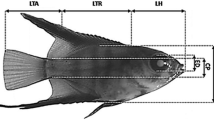Summary
-
1.
During normal growth of the pistol-crab,Alpheus dentipes, the distribution of growth potential along the antero-posterior axis of the body takes the form of a growth gradient with its high point in the chelae-bearing segment. Values of k are presented in the text.
-
2.
During regenerative growth of the thoracic appendages the normal growth gradient is maintained, with slight modification; the relative rate of growth in length of the chelae is reduced.
-
3.
The absolute and relative rate of regeneration of thoracic appendages is exceedingly rapid (see text for values) and varies with body size. Large males used in these experiments regenerate roughly twice the absolute length of appendage regenerated by small males, during the mean day, but form smaller fractions of normal appendage length.
-
4.
Logarithmic plots of carapace length against appendage length at the end of the period of regeneration yield approximations to straight lines in every instance.Huxley's idea of growth partition receives support and is shown to apply in regeneration as in normal growth.
-
5.
The partition coefficients for regenerative growth are smaller than those for normal growth, in general. The constant fractional factor kR/kN is considerably less than unity in the male crusher and its propus and it is suggested that small values of this constant are correlated with high normal growth coefficients.
Zusammenfassung
-
1.
Während des normalen Wachstums der PistolenkrabbeAlpheus dentipes nimmt die Verteilung des Waohstumspotentiales in Richtung der antero-posterioren Körperachse die Form eines Wachstumsgefälles an, mit dem Maximum in demjenigen Segment, welches die Scheren trägt. Die Werte von k sind im Text angegeben.
-
2.
Während des regenerativen Wachstums der Appendices thoracicae bleibt das normale Wachstumsgefälle mit einer geringen Modifikation erhalten die relative Geschwindigkeit des Längenwachstums der Scheren ist vermindert
-
3.
Die absolute und relative Regenerationsgeschwindigkeit der Appendices die regenerierten Appendices absolut gemessen ungefähr doppelt so lang at bei den kleinen Munchen, im täglichen Durchschnitt, jedoch war nur ein kleiner Teil der normalen Appendixl:ange regeneriert.
-
4.
Werden die Logarithmen der Rückenschildlänge und der Appendixlänge am Ende der Regenerationsperiode zueinander in Beziehung gesetzt, so ergeben sich in jedem Fall ungefähr gerade Linien; dadurchHuxleys Ansicht der Wachstumsverteilung gestützt und gezeigt, daß diese sowohl für die Regeneration als auch dasnormale Wachstum gilt.
-
5.
Die Verteilungskoeffizienten für das regenerative Wachstum sind im allgemeinen kleiner als für das normale Wachstum. Der konstante Bruchfaktor kR/kn ist beträchtlich kleiner als 1 bei dem männlichen knacker und seinem Propus, und es wird die Ansicht geäußert, daß kleine Werte dieser Konstante mit hohen Werten normaler Wacstumskoeffizienten verknüpft sind.
Similar content being viewed by others
Author information
Authors and Affiliations
Rights and permissions
About this article
Cite this article
Dawes, B. Gradients of normal and regenerative growth in the pistol-crab, alpheus dentipes.. W. Roux' Archiv f. Entwicklungsmechanik 130, 649–659 (1933). https://doi.org/10.1007/BF01380615
Received:
Issue Date:
DOI: https://doi.org/10.1007/BF01380615



